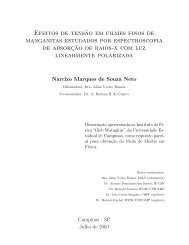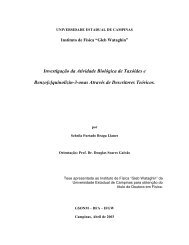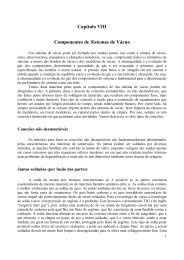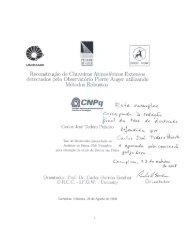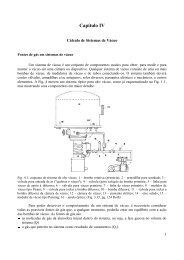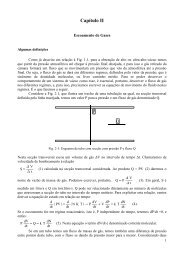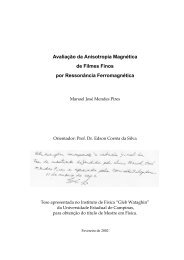Faça o download da tese completa na versão em PDF - A Biblioteca ...
Faça o download da tese completa na versão em PDF - A Biblioteca ...
Faça o download da tese completa na versão em PDF - A Biblioteca ...
Create successful ePaper yourself
Turn your PDF publications into a flip-book with our unique Google optimized e-Paper software.
Figure 1. HRTEM images of [100] gold <strong>na</strong>nowire time evolution.<br />
A linear chain with two atoms is formed in (d), and in (e) the<br />
number of gold atoms has increased to three (indicated by arrows)<br />
before breaking (f). See text for discussions.<br />
<strong>na</strong>nometric bridges (or NWs) are formed between neighboring<br />
holes. To perform the atomic resolution image acquisition,<br />
the electron beam intensity is reduced to ∼30 A/cm 2<br />
(see Supporting Information, video 1). Subsequently, the<br />
bridges spontaneously elongate and fi<strong>na</strong>lly break due to<br />
relatively slow mov<strong>em</strong>ents of the apexes. A high sensitivity<br />
TV camera (Gatan 622SC, 30 frames/s) was used to record<br />
NW real-time evolution.<br />
In Figure 1 we present a sequence of s<strong>na</strong>pshots of the<br />
formation of linear atomic suspended gold chains (LACs).<br />
NWs elongate spontaneously and become thinner (Figure 1c);<br />
in some cases the apexes slide (Figure 1b). Before the NW<br />
rupture linear chains can be formed whose lengths are in<br />
the 2-4 atoms range (Figures 1d and 1e), these linear chains<br />
may last several seconds before breaking (Figure 1d) and<br />
then the apexes retract (Figure 1f). The whole dy<strong>na</strong>mical<br />
process can be better visualized in the movie of the<br />
experimental realization (Supporting Information, video 2).<br />
33<br />
Figure 2. HRTEM images of gold <strong>na</strong>nowire formation for different<br />
crystallograhic directions.<br />
A whole a<strong>na</strong>lysis of linear atomic chain formation in gold<br />
has been previously reported in ref 12.<br />
The structural and dy<strong>na</strong>mic features are quite different<br />
depending on the crystallographic orientation of the NW<br />
elongation direction (Figure 2 and videos 3-5, SI). Just<br />
before rupture, gold NWs are crystalline and free of defects;<br />
in particular, they assume only three kinds of atomic<br />
arrang<strong>em</strong>ents, where the NW structure adjusts such that one<br />
of the [111]/[100]/[110] gold zone axes lies approximately<br />
parallel to the elongation direction. 8 One example of each<br />
kind of NW is shown in Figure 2. In addition, using timeresolved<br />
HRTEM, we have observed that [111] and [100]<br />
NWs form biconical constrictions with ductile behavior,<br />
allowing the evolution to one-atom-thick contact (see Figure<br />
2a and 2b). On the other hand, [110] NWs display rod-like<br />
morphology (see Figure 2c) and break abruptly when they<br />
are rather thick (3-4 atoms), alike a brittle material. The<br />
effect of elongation direction on the morphology, structure,<br />
and conductance has already been thoroughly a<strong>na</strong>lyzed in<br />
refs 8 and 23.<br />
To theoretically address the wire elongation dy<strong>na</strong>mics, it<br />
is necessary to have a realistic description of the experimentally<br />
generated NWs. To do so, syst<strong>em</strong>s with thousands<br />
of atoms should be considered, which precludes the use of<br />
ab initio or even s<strong>em</strong>i<strong>em</strong>pirical quantum methods. For this<br />
purpose, we have developed a methodology based on tightbinding<br />
molecular dy<strong>na</strong>mics (TB-MD) 30 techniques using<br />
second-moment approximation (SMA) 31 with a small set of<br />
adjustable parameters. This approach is based on the wellknown<br />
fact that cohesive properties of transition metals and<br />
their alloys origi<strong>na</strong>te mainly from the large d-band density<br />
of states (DOS). Also, thermody<strong>na</strong>mic and structural quantities<br />
have been shown to be insensitive to the DOS details. 32<br />
These magnitudes are domi<strong>na</strong>ted by the electronic bandwidth.<br />
This TB-SMA molecular dy<strong>na</strong>mics approach has proved<br />
1188 Nano Lett., Vol. 4, No. 7, 2004



